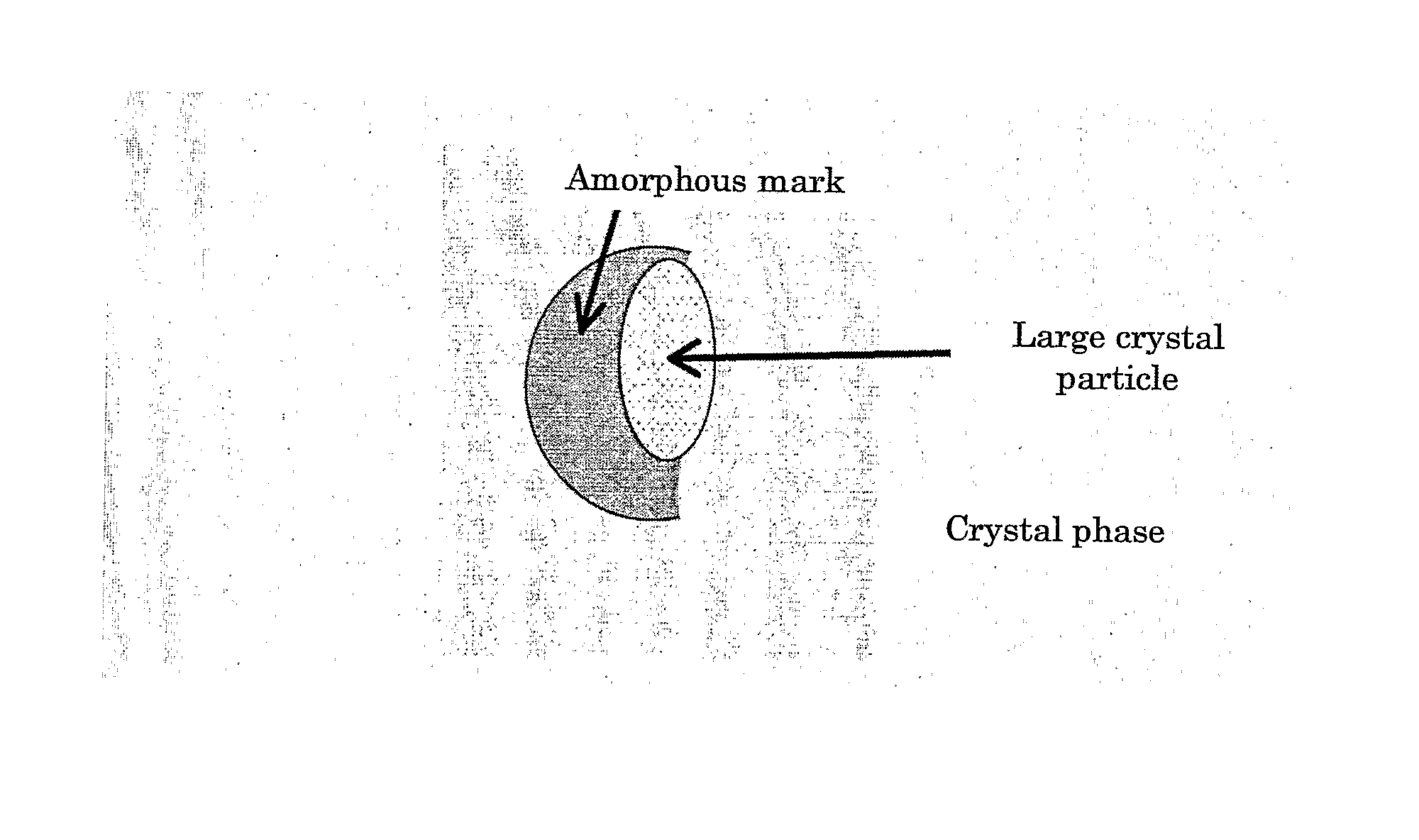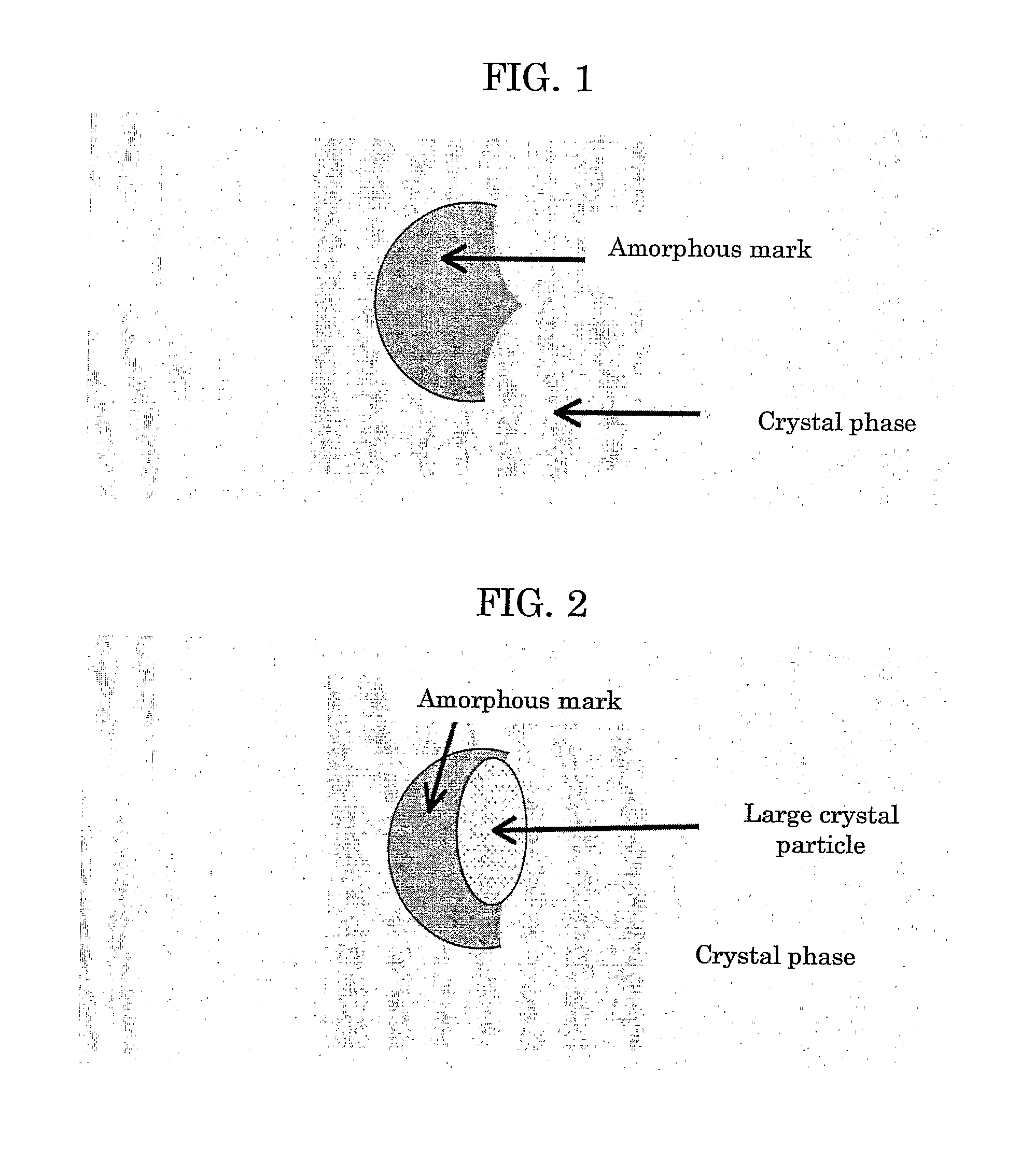Optical recording medium
a recording medium and optical recording technology, applied in the field of rewritable optical recording medium, can solve the problems of reduced crystallization temperature in the recording layer, amorphous marks are prone to crystallization, and the shape of amorphous marks is not uniform, so as to achieve excellent high-recording characteristics, large width, and large modulation degree
- Summary
- Abstract
- Description
- Claims
- Application Information
AI Technical Summary
Benefits of technology
Problems solved by technology
Method used
Image
Examples
example 1
[0053]A phase change optical recording medium (disc) was manufactured in the manner described below.
[0054]Note that sputtering was conducted using a single-wafer sputtering device (by UNAXIS) under the following condition: atmosphere=Ar gas, power=1-5 kW, Ar gas pressure=2×10−3 Torr. On a polycarbonate substrate that is 12 cm in diameter and 0.6 mm in thickness and has a groove of 27 nm depth and 0.74 μm track pitch, a first protective layer, a phase change recording layer, a second protective layer, and a reflective layer were sequentially deposited by means of sputtering method. The first protective layer was formed by sputtering of In2O3—SnO2 (90:10 wt %) and deposited to a thickness of 70 nm. The phase change recording layer was formed by sputtering of Sb71Sn19Ge5Ga5 (atomic %) and deposited to a thickness of 14 nm. The second protective layer was formed by sputtering of ZnS—SiO2 (80:20 mol %) and deposited to a thickness of 8 nm. The reflective layer was formed by sputtering of...
example 2
[0055]A phase change optical recording medium was produced as in Example 1 except that the first protective layer was formed using ZnS—SiO2 (80:20 mol %) and deposited to a thickness of 60 nm, the recording layer was formed using Sb75In18Zn3Ge4 (atomic %) and the second protective layer was formed using Nb2O5 and deposited to a thickness of 15 nm. Table 1 lists layer compositions of this disc.
example 3
[0056]A phase change optical recording medium was produced as in Example 1 except that the first protective layer was formed using ZnO and deposited to a thickness of 60 nm and the recording layer was formed using Sb78In18Zn4 (atomic %). Table 1 lists layer compositions of this disc.
[0057]
TABLE 1Layer constitutionFirst protectiveSecond protectiveEx.layerRecording layerlayerReflective layer1In2O3—SnO2 (70 nm)Sb71Sn19Ga5Ge5 (16 nm)ZnS—SiO2(8 nm)Ag alloy(200 nm)2ZnS—SiO2 (60 nm)Sb75In18Zn3Ge4 (14 nm)NbO2(15 nm)Ag alloy(201 nm)3ZnO (60 nm)Sb78In18Zn4 (14 nm)ZnS—SiO2(8 nm)Ag alloy(202 nm)
[0058]Initial crystallization was conducted on each of the phase change optical recording media prepared in Examples 1 to 3 using an initializing device (POP120-7AH, manufactured by Hitachi Computer Peripherals Co., Ltd.) equipped with a laser head that produces a laser beam of 810 nm wavelength and a laser spot of about 1 μm width and 75 μm length and that features a laser focusing function. Initializat...
PUM
| Property | Measurement | Unit |
|---|---|---|
| crystal particle diameter | aaaaa | aaaaa |
| crystal particle diameter | aaaaa | aaaaa |
| linear velocity | aaaaa | aaaaa |
Abstract
Description
Claims
Application Information
 Login to View More
Login to View More - R&D
- Intellectual Property
- Life Sciences
- Materials
- Tech Scout
- Unparalleled Data Quality
- Higher Quality Content
- 60% Fewer Hallucinations
Browse by: Latest US Patents, China's latest patents, Technical Efficacy Thesaurus, Application Domain, Technology Topic, Popular Technical Reports.
© 2025 PatSnap. All rights reserved.Legal|Privacy policy|Modern Slavery Act Transparency Statement|Sitemap|About US| Contact US: help@patsnap.com



